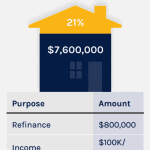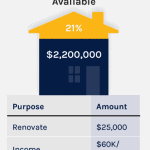Whether fully self-funded or partly reliant on the Age Pension – or anywhere in between – most sources of retirement income have come under stress this year. Dividends have been slashed. Interest rates have continued to fall, and rates on retirement savings accounts have been pushed even lower by banks. Income streams from rental properties have dried up.
Although super fared better than expected, ending the 2020 financial year flat, it’s certainly not a growth environment. Increasing drawdowns at this time isn’t ideal, as there will be less capital to generate future returns, including income.
A bricks and mortar solution
There’s no doubt the savings retirees have made in their homes, coupled with growth from capital gains over the years, could transform retirement for many Australians.
Home equity is the market value of a home, minus any outstanding debts the client may have registered against it. Equity release is the mechanism through which your clients can access some of the wealth locked up their family home.
Home equity can be accessed by selling the home and downsizing, or through a range of credit or financial products. Each of the available products allows retirees to access some of their home’s value.
Downsizing
Selling the family home, moving to a lower-priced property and using the difference to fund retirement is often suggested as a way to access to home equity. Retirees choosing to downsize can benefit from the federal government’s downsizing initiative which, subject to meeting criteria, allows
$300,000 of the proceeds to be used to make a non-concessional contribution to super.
Depsite this, only around 20% of Australian retirees downsize. Limited availability of lower-priced accommodation may result in retirees having to leave their community to capture meaningful proceeds from downsizing. Leaving established social support structures, friends and family can negatively impact happiness and wellbeing.
Home reversion schemes
A home reversion scheme is not a loan – it’s a partial sale. Instead of borrowing against the value of the home, the client agrees to sell a share of the future sale proceeds of their home in exchange for a lump sum payment now.
This is generally sold at a significant discount to the home’s current value. The price is adjusted to allow for imputed rent on the portion of the home sold. The discount applied is age based, and decreases with age. When the house is sold, the home reversion scheme provider receives the value of the proportion of equity it purchased, at the future price.
Centrelink Pension Loans Scheme (PLS)
If a client receives an eligible pension – and they’re of Age Pension age – the Centrelink Pension Loans Scheme (PLS) reverse mortgage allows the retiree to receive an additional income stream by taking out a loan against the equity in their home.
Administered by the Department of Human Services, the scheme allows the client to borrow up to 1.5 times of the maximum Age Pension, paid in fortnightly instalments. It is not available as a lump sum (capital) payment.
Reverse mortgages
A reverse mortgage is the primary mechanism used by retired Australians to access their home equity and is achieved via a loan facility that doesn’t require repayment until the property is vacated.
As with a standard home loan, a reverse mortgage is secured by registering a first mortgage over the property. The primary difference between a standard home loan and reverse mortgage is that regular repayments aren’t required.
As a result, the monthly interest compounds over time and increases the balance of the loan, unless monthly interest payments are made. The homeowner retains ownership and reaps the benefits of growth in the property’s value.
What is a Household Loan?
A Household Loan is an innovative type of reverse mortgage that’s been designed to meet the needs of Australian retirees and work within Australia’s retirement system.
Designed for those aged 60+, it allows applicable clients to access a portion of their home equity to improve their retirement funding and meet their lifestyle needs.
A Household Loan provides your clients with flexibility and choice to improve their home, lifestyle and wellbeing while they continue to live in their family home.
We find retirees are using a Household Loan for a range of purposes, to increase retirement income, for capital, or a mix of the two. An increasing number of retirees with mortgages are wanting to refinance with a Household Loan so they can free up their retirement cashflow. Uses for a Household Loan can be put into six categories:

Regular income
Household Capital introduced its Home Income solution to enable retirees access their home equity to draw a regular income, fortnightly or monthly, to improve overall retirement funding, make it easy for your clients to deal with their expenses and look forward with confidence.
For those client who need a smaller income, less than 1% of their home equity each year, a simple online application can be made. Funds are generally available within two weeks. This can be established as a long term funding solution, or an income stream to see clients through this challenging period.
Refinance
A recent survey of retirees 1 found that 87 percent believed Australia’s big banks have largely abandoned the needs of retirees. A large number are having interest only loans being converted to principal and interest with little warning, while others seeking credit are being knocked back.
Regular repayments made to an existing mortgage or other debt can eat into retirement funding and mortgage stress is impacting a growing number of retirement-age Australians.
A Household Loan has three key benefits for retirees over a traditional bank mortgage:
- Improved retirement funding – because the client doesn’t have to make repayments, the money being used to service the loan can instead be used to fund retirement
- Interest payment flexibility – clients can choose to make regular interest repayments, however, there is no obligation to do so
- Guaranteed occupancy – whether your client elects to make repayments or not, they are guaranteed occupancy of their home until they choose to leave it.
Case study one: The unplanned retirement
Greg is 66 years old and lives in McMahon Point, Sydney. He has a younger partner and two children, one of whom is completing Year 12 at a private school. His house represents the majority of his wealth, recently valued at $7.6 million.

Live
The recent COVID-19 crisis has forced Greg to bring forward plans to retire. He had planned to continue to work for several more years to pay down his mortgage, get the kids through school and university, and then realise the value of his property by downsizing. Greg had been self-employed for a good part of his career and does not have much super savings.
Household Capital was able to refinance a large outstanding home loan ($800K) and provide an income for the next five years. Drawing on a small part of his home equity, Greg has been able to improve his income by no longer making home loan repayments and he also established a regular income stream.
Case study two: Preserving capital in a tough market
Alison lives in Hampton, Victoria and is a self-funded retiree with significant assets outside the family home. She owns a holiday house in Anglesea unencumbered, has a Challenger annuity, and investments valued at $220,000.

Alison currently draws $5,000 per month from her investments, but plans to decrease this to the minimum drawdown amount to preserve her capital while investment markets remain volatile.
Household Capital provided Alison with the funds she needed to renovate her kitchen, as well as a regular income stream so she can preserve her invested capital at this time.
Top Up
Some Australian retirees’ superannuation falls short. When compulsory superannuation was introduced in 1992, many baby boomers were more than halfway through their working life. As a result, many retirees experience a shortfall in superannuation; the result can be inadequate income throughout retirement or insufficient funds to meet capital spending needs and unexpected expenses.
A Household Loan can help your client access some of the value of their home to top up their super or other investments to boost their overall retirement funding.
Give
The ‘bank of mum and dad’ now ranks as Australia’s tenth largest lender, accounting for more than
$29 billion in funding2. Typically funds are drawn from savings, often depleting long term retirement funding.
It’s important to ensure that intergenerational wealth transfer is responsible; if your client’s retirement funding needs are in hand, they can use their home equity to contribute to a first home buyers deposit, help children with mortgage expenses or cover the costs of education. This approach enables your clients to help children and grandchildren when they need it most.
Care
The waiting list for government funded in-home care packages is significant. There are currently more than 100,000 people waiting for care, and many have to accept packages providing a lower level of care than needed.
You may have clients who themselves need to transition to aged care, or have parents who do. In the current environment, it’s not surprising that a number of people don’t want to enter residential aged care unless their needs are acute.
Either way, finding the right care is complex and expensive. In the case of aged care, it may seem the only funding option available is to sell the family home. This may not be the best decision financially, emotionally or for the beneficiaries.
A Household Loan provides choice and flexibility; it can pay for the RAD and broaden the care choices available.
A Household Loan provides flexibility and choice to improve the home, lifestyle and wellbeing of retiree clients, particularly in the current challenging environment.
Household Capital is different to other lenders because:
- We offer a consistently low rate on reverse mortgage at 8.95, 8.98 comparison.
- Our focus is on providing long-term, responsible retirement funding that meets your clients’ needs
- We provide your clients with flexibility and choice
- Our team provides personalised service.
Sources
1 Your Life Choices Survey, December 2019
2 Australian Prudential Regulatory Authority (APRA)
Household Capital Pty Limited ACN 618 068 214 is the issuer of the information on this website. Household Capital Pty Limited ACN 618 068 214, Australian Credit Licence 545906, is the Servicer for the credit provider Household Capital Services Pty Limited ACN 625 860 764. HOUSEHOLD CAPITAL, HOUSEHOLD TRANSFER, LIVE WELL AT HOME and the Star Device are trademarks of Household Capital Pty Ltd
Disclaimer: Comparison rate based on a secured loan of $150,000 over a 25 year term. WARNING: This comparison rate applies only to the example or examples given. Different amounts and terms will result in different comparison rates.
Costs such as redraw fees or early repayment fees, and cost savings such as fee waivers, are not included in the comparison rate but may influence the cost of the loan. ^Amounts spent will be added to your Household Loan and accrue interest like any other funds drawn via your Household Loan.






